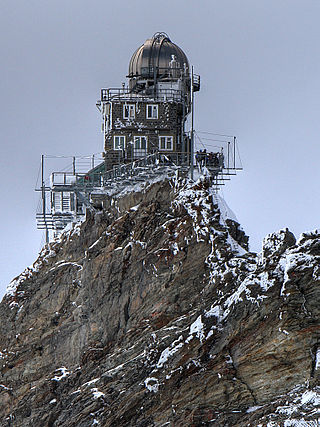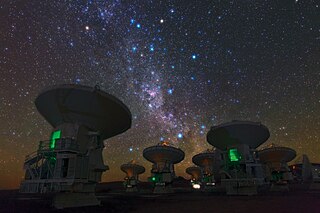
A radio telescope is a specialized antenna and radio receiver used to detect radio waves from astronomical radio sources in the sky. Radio telescopes are the main observing instrument used in radio astronomy, which studies the radio frequency portion of the electromagnetic spectrum, just as optical telescopes are used to make observations in the visible portion of the spectrum in traditional optical astronomy. Unlike optical telescopes, radio telescopes can be used in the daytime as well as at night.

An observatory is a location used for observing terrestrial, marine, or celestial events. Astronomy, climatology/meteorology, geophysics, oceanography and volcanology are examples of disciplines for which observatories have been constructed.

Very-long-baseline interferometry (VLBI) is a type of astronomical interferometry used in radio astronomy. In VLBI a signal from an astronomical radio source, such as a quasar, is collected at multiple radio telescopes on Earth or in space. The distance between the radio telescopes is then calculated using the time difference between the arrivals of the radio signal at different telescopes. This allows observations of an object that are made simultaneously by many radio telescopes to be combined, emulating a telescope with a size equal to the maximum separation between the telescopes.

The Goldstone Deep Space Communications Complex (GDSCC), commonly called the Goldstone Observatory, is a satellite ground station located in Fort Irwin in the U.S. state of California. Operated by NASA's Jet Propulsion Laboratory (JPL), its main purpose is to track and communicate with interplanetary space missions. It is named after Goldstone, California, a nearby gold-mining ghost town.

Ventspils International Radio Astronomy Centre is an ex-Soviet radio astronomy installation 30 km north of Ventspils, Latvia, on the coast of the Baltic Sea in Ance parish. The installation was secret until 1993 after Latvia regained independence. It was taken over by the Latvian Academy of Sciences after the withdrawal of the Soviet Army in 1994. Since then, two of the three radio telescopes have been repaired and renewed.

The Hartebeesthoek Radio Astronomy Observatory (HartRAO) is a radio astronomy observatory, located in a natural bowl of hills at Hartebeesthoek just south of the Magaliesberg mountain range, and about 50 km west of Johannesburg, Gauteng, South Africa. It is a National Research Facility run by South Africa's National Research Foundation. HartRAO was the only major radio astronomy observatory in Africa until the construction of the KAT-7 test bed for the future MeerKAT array in the Meerkat National Park.

The Indian Space Research Organisation (ISRO), over the years, has established a comprehensive global network of ground stations to provide Telemetry, Tracking and Command (TTC) support to satellite and launch vehicle missions. These facilities are grouped under ISRO Telemetry, Tracking and Command Network (ISTRAC) with its headquarters at Bangalore, India.

Third-party evidence for Apollo Moon landings is evidence, or analysis of evidence, about the Moon landings that does not come from either NASA or the U.S. government, or the Apollo Moon landing hoax theorists. This evidence provides independent confirmation of NASA's account of the six Apollo program Moon missions flown between 1969 and 1972.

Aleksandr Leonidovich Zaitsev was a Russian and Soviet radio engineer and astronomer from Fryazino. He worked on radar astronomy devices, near-Earth asteroid radar research, and SETI.

There are three radio telescopes designated RT-70, all in countries that were once part of the former Soviet Union, all with similar specifications: 70m dishes and an operating range of 5–300 GHz. They are a part of the former Soviet Deep Space Network, now operated by Russia. The Yevpatoria facility has also been used as a radar telescope in observations of space debris and asteroids.

The Yevpatoria RT-70 radio telescope is an RT-70 radio telescope and planetary radar at the Center for Deep Space Communications, Yevpatoria, Crimea. In scientific literature, it is often called the Evpatoria Planetary Radar (EPR).

The Galenki RT-70 radio telescope is an RT-70 telescope at the East Center for Deep Space Communications, Galenki (Ussuriysk), Russia.
The Suffa RT-70 radio telescope is an RT-70 radio telescope at the Suffa Radio Observatory on the Suffa plateau in Uzbekistan.

Pluton is a system of deep space communications and planetary radar in Crimea. It was built in the Deep Space Communication Center area 85th Radiotechnical Center of Distance Communications with Space Objects in the then Yevpatoria Raion in 1960.

Pushchino Radio Astronomy Observatory is a Russian radio astronomy observatory. It was developed by Lebedev Physical Institute (LPI), Russian Academy of Sciences within a span of twenty years. It was founded on April 11, 1956, and currently occupies 70 000 square meters.
This enclave of scientific research is officially known as Astro Space Center of PN Lebedev Physics Institute, and is under the purview of the Russian Academy of Sciences. Generally speaking, the space center's mission focuses on astrophysics, which includes cosmology. The emphasis is on accomplishing basic research in this science. The research leads into exploring the composition, and structure of astronomical objects, interstellar and interplanetary space along with exploring how these evolved.

The Chinese Deep Space Network (CDSN) is a network of large antennas and communication facilities that are used for radio astronomy, radar observations, and spacecraft missions of China. The CDSN is managed by the China Satellite Launch and Tracking Control Center General (CLTC) of the People's Liberation Army Strategic Support Force Space Systems Department.
The Soviet Deep Space Network is a network of large antennas and communication facilities that support interplanetary spacecraft missions, and radio and radar astronomy observations for the exploration of the Solar System and the universe during Soviet times. It was built to support the space missions of the Soviet Union. Similar networks are run by the USA, China, Europe, Japan, and India.
The Xinjiang Qitai 120m Radio Telescope (QTT) is a planned radio telescope to be built in Qitai County in Xinjiang, China. Upon completion, which is scheduled for 2028, it will be the world's largest fully steerable single-dish radio telescope. It is intended to operate at 150 MHz to 115 GHz. The construction of the antenna project is under the leadership of the Xinjiang Astronomical Observatory of the Chinese Academy of Sciences.














